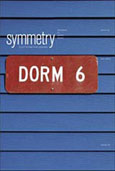

Thursday - November 16, 2006
SLAC Today is
available online at:
http://today.slac.stanford.edu
In this issue:
New Issue of symmetry Released
Science Today: Supersymmetry at Work for QCD
Photo of the Day: Guest House Celebration
International Science Grid This Week Releases First Issue
 |
 |
|
Thursday - November 16, 2006 |
 New Issue of symmetry Released Today
You can read the magazine online, pick up a print copy at various locations around SLAC, or subscribe to the mailing list by filling out an online form. |
||
|
|
||
 Supersymmetry at
|
Photo of the Day: Guest House Celebration
Amidst sunny skies and red and white balloons, the former SLAC Guest House opened its doors on Wednesday with a new name: the Stanford Guest House. More than 200 visitors attended a re-christening open house that featured facility tours, complimentary lunch, and a prize raffle. International Science Grid This Week Releases First Issue
This morning, the worldwide science grid community launched International Science Grid This Week, a weekly publication reporting news and information about grid computing projects and collaborations, and the scientific research that uses grid computing technology. The publication is the result of a collaboration between the Open Science Grid and Enabling Grids for E-sciencE projects. "Scientists use grid computing today to fight disease, develop new semiconductors and study the origins of the universe," said Open Science Grid Executive Director Ruth Pordes. "We're proud to support a newsletter that will tell the story of the people and projects building grids around the world, and the scientists using them for discovery." International Science Grid This Week builds on the success of its predecessor, Science Grid This Week, which focused on grid projects in the United States and their use in scientific research. The new publication will use articles, images, links and multimedia content to tell the story of scientific grid computing around the world. Read the first issue of International Science Grid This Week and subscribe online. |
Events (see all | submit)
Access (see all)
Announcements
|
| | ||
|
|
||
 <%
Response.AddHeader "Last-modified", getArticleDate()
'Response.AddHeader "Last-modified","Mon, 01 Sep 1997 01:03:33 GMT"
'Monday, December 06, 2010
%>
<%
Response.AddHeader "Last-modified", getArticleDate()
'Response.AddHeader "Last-modified","Mon, 01 Sep 1997 01:03:33 GMT"
'Monday, December 06, 2010
%>View online at http://today.slac.stanford.edu/. |
||